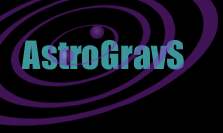
News /
Reports
Images & Movies
Links
Galactic Binaries
Binary star systems in the our Milkyway galaxy are a key gravitational wave source. LISA should observe thousands of these systems, so many, in fact, that observation of the weaker cases will be limited by confusion among many similar signals. Stronger signals will rise above the fray. Uniquely for this class of LISA sources, astronomers are already aware of specific galactic binary systems which LISA must be able to observe in gravitational waves if the instrument is working properly and the basic principles of Einstein's General Relativity are correct.The data sets below each correspond to an example of a binary system in our galaxy. The files linked under the heading "Incident Wave Data" contain data describing the gravitational waves arriving from these sources at the solar barycenter. The "Output Data" contain simulated output from LISA for these events. The output data are of two varieties, Time Delay Interferometry (TDI) outputs, corresponding to the proposed interferometry scheme for LISA, and Michelson outputs, assembled from the TDI information to correspond to more traditional interferometry.
AM CVn mock data
Jump to:| Caltech Group - November 2003 | ||||
|---|---|---|---|---|
|
AM CVn | ||||
| Contributor | Description | Incident Wave Data | Output Data | Images |
|---|---|---|---|---|
| Caltech Group | Text Description File directory | Barycenter (398Mb) |
Michelson (2Gb) TDI (2Gb) |
Images directory |